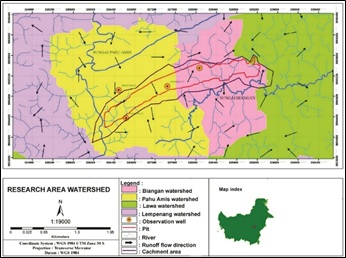Groundwater Effect on Slope Stability in Open Pit Mining: a Case of West Kutai Regency, East Kalimantan, Indonesia
DOI:
https://doi.org/10.25299/jgeet.2021.6.4.6226Keywords:
Finite Element Method, Groundwater Modelling, Slope Stability, West KutaiAbstract
The stability of open pit slopes in Biangan district, West Kutai Regency, East Kalimantan Province, is greatly influenced by groundwater conditions. The existence of groundwater reduces the shear strength of the materials which causes a decrease in the stability value of pit slopes. The main objective of this study is to assess the impact of groundwater on the stability of the low wall and high wall pit mining. Groundwater modeling is used to determine the prediction of groundwater level on the pit slope which determines the value of the slope stability. Slope stability analysis in this study was performed using the Finite Element Method, producing output in the form of strain zones, deformation and displacement values. Therefore, the Strength Reduction Factor (SRF) approach was used, which is a gradual reduction of shear strength until the values of cohesion and friction angles reach minimums and the slopes are at a critical state. Groundwater modeling results indicate that groundwater flows to the Biangan river with hydraulic heads between 76 and 108 meters above sea level. Based on the analysis using the Finite Element Method, the stability values of the pit slopes, which are influenced by groundwater, are 0.65 on the low wall and 1.40 on the high wall. The total displacements are 0.019 meters on the low wall and 0.002 meters on the high wall. The impact of groundwater on the slope is an increase in the slope load. This increases the materials’ thrust and reduces the shear strength of the materials which reduces the rock mass that can function as a water seepage path. Thus, the recommendation for low wall pit construction is a safety factor of 7.79 with a total displacement of 0.020 meters.
Downloads
References
Alfreds, R.J., 1983, Rock Mechanics (Second Edition), Trans Tech Publication, ISBN: 0882759698
Arif, I., 2016, Mining Geotechnics, Gramedia Pustaka Utama, Jakarta.
Boonstra, J., and de Ridder, N.A., 1981, Numerical Modelling of Groundwater Basins, International Institute for Land Reclamation and Improvement / ILR, Wageningen, The Netherland.
Devy, S.D., 2018, Hydrogeology of Karang Mumus Watershed in Samarinda, East Kalimantan Province, Indonesia, Forum Geografi, Vol. 32 (1) 2018, ISSN: 0852-0682; E-ISSN: 2460-3945
Devy, S.D., and Sarungallo, C., 2018, Groundwater aquifer study on coal mining area: a case of North Samarinda, Indonesia, Journal of Degraded and Mining Lands Management, Universitas Brawijaya Malang, Vol. 32 (1) 2018, Oktober 2018: ISSN: 2339-076X (p), 2502-2458 (e), p. 1483-1493.
Fabbri, P., Ortombina, M., dan Piccinini, L., 2012, Estimation of Hydraulic Conductivity Using the Slug Test Method in a Shallow Aquifer in the Venetian Plain (NE, Italy), Associazione Acque Sotterranee, Padova, Italy.
Fetter, C.W., 2001, Applied Hydrogeology, 4th edition, Prentice Hall, Upper Saddle River, New Jersey, The United States of America.
Haq, S.R., Putra, D.P.E., Hendrayana, H., Igarashi, T., 2016, Hydrogeology of an Open-Pit Coal Mine in Tamiang Layang, Central Kalimantan, Indonesia: Preliminary Groundwater Flow Modeling.
https://www.researchgate.net/publication/320920036
Harbaugh, A.W., Banta, E.R., Hill, M.C., and McDonald, M.G., 2005, Visual Modflow, The U.S. Geological Survey Modular Ground Water Model, the Ground Water Flow Process, U.S Geological Survey Techniques and Methods, Reston, Virginia, The United States of America.
Hustrulid, W., and Kuchta, M., 1998, Open Pit Mine Planning and Design, vol. 1, A. A. Balkema, Rotterdam, The Netherlands.
Hustrulid, W., Kuchta, M., Martin, R., 2006, Open Pit Mine Planning and Design, 3rd edition, Taylor and Francis plc, London, The United Kingdom.
Konikow, L.F., and Reilly, T., 1999, Groundwater Modelling, School of Civil Engineering: Purdue University Press, Indiana, The United States of America.
Locat, J., Leroueil S., Locat, A., Lee, H., 2014, Weak Layers: Their Definition and Classification from a Geotechnical Perspective Advances in Natural and Technological Hazards Research: Submarine Mass Movements and Their Consequences, Vol 37, Springer, Switzerland.
Spitz, K., dan Moreno, J., 1996, A Practical Guide to Groundwater and Solute Transport Modeling, John Wiley and Sons, Inc., New York, The United States of America.
Supriatna, S., Sudradjat, A., dan Abidin, H.Z., 1995, Peta Geologi Lembar Muaratewe, Kalimantan, Skala 1: 250.000, Puslitbang Geologi Bandung.
Van Zuidam, R.A., 1983, Guide to Geomorphologic – Aerial Photographic Interpretation and Mapping, ITC, Enschede, The Netherlands.
Wyllie, D.C., and Mah, C.W., 2004, Rock Slope Engineering: Civil and Mining, 4th edition, Spon Press, New York, The United States of America.

Downloads
Published
Issue
Section
License
Copyright @2019. This is an open-access article distributed under the terms of the Creative Commons Attribution-ShareAlike 4.0 International License which permits unrestricted use, distribution, and reproduction in any medium. Copyrights of all materials published in JGEET are freely available without charge to users or / institution. Users are allowed to read, download, copy, distribute, search, or link to full-text articles in this journal without asking by giving appropriate credit, provide a link to the license, and indicate if changes were made. All of the remix, transform, or build upon the material must distribute the contributions under the same license as the original.










